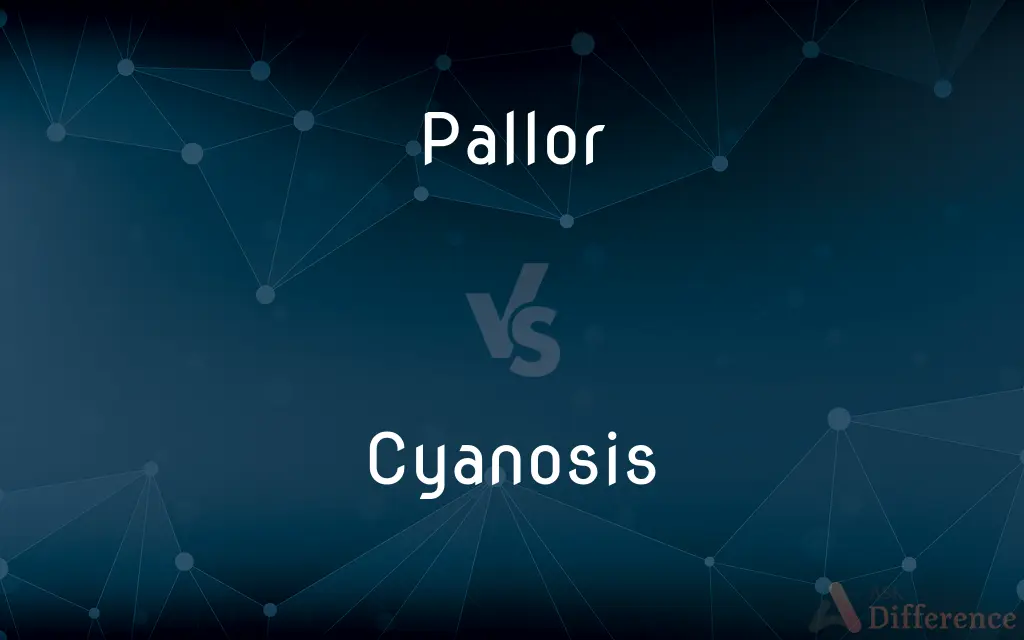Pallor vs. Cyanosis — What's the Difference?
By Tayyaba Rehman — Updated on October 26, 2023
Pallor refers to paleness of the skin, while Cyanosis is a bluish discoloration of the skin or mucous membranes due to insufficient oxygen in the blood.

Difference Between Pallor and Cyanosis
Table of Contents
ADVERTISEMENT
Key Differences
Pallor and Cyanosis are clinical signs that provide valuable insights into a person's health. Pallor, originating from the Latin word for "pale", describes an unusual lightness or absence of color in the skin, often resulting from reduced blood flow or decreased red blood cell count. Cyanosis, on the other hand, indicates a bluish tint, especially in the mucous membranes and skin. This bluish tint arises from an increased concentration of deoxygenated hemoglobin in the blood.
While both Pallor and Cyanosis are alterations in skin and mucous membrane color, they signify different underlying conditions. Pallor can be a manifestation of anemia, fainting, or arterial insufficiency. Cyanosis is typically a sign that there's an issue with oxygenation, suggesting conditions like chronic obstructive pulmonary disease (COPD), congenital heart diseases, or pulmonary embolism.
When examining a patient, healthcare professionals closely observe for Pallor and Cyanosis. Pallor might be more noticeable in areas like the face, palms, or nails, suggesting issues with peripheral perfusion. Cyanosis, however, might first manifest in the lips, tongue, and extremities, indicating central or peripheral oxygenation issues respectively.
Both Pallor and Cyanosis require further evaluation to determine their root causes. While Pallor might lead a clinician to investigate hematologic issues, Cyanosis often prompts an in-depth cardiovascular or pulmonary evaluation. Both signs are crucial diagnostic tools, emphasizing the importance of comprehensive physical examinations.
Comparison Chart
Definition
Paleness of the skin.
Bluish discoloration of the skin/mucous membranes.
ADVERTISEMENT
Underlying Causes
Reduced blood flow or decreased red blood cell count.
Insufficient oxygen in the blood.
Associated Conditions
Anemia, fainting, arterial insufficiency.
COPD, congenital heart diseases, pulmonary embolism.
Primary Manifestation
Face, palms, nails.
Lips, tongue, extremities.
Diagnostic Implication
Indicates potential hematologic issues.
Suggests cardiovascular or pulmonary problems.
Compare with Definitions
Pallor
A whitish or ashen appearance of the skin.
The pallor of her complexion was striking.
Cyanosis
Indication of an increase in deoxygenated hemoglobin.
Her cyanosis was a result of prolonged respiratory distress.
Pallor
An indication of reduced blood flow or oxygenation.
The patient's pallor concerned the attending nurse.
Cyanosis
A sign of decreased oxygen saturation in the blood.
The doctor observed cyanosis in the patient's fingertips.
Pallor
An abnormal paleness or absence of color in the skin.
She showed pallor after the sudden shock.
Cyanosis
Manifestation of certain cardiovascular or respiratory conditions.
Cyanosis was a symptom of his congenital heart defect.
Pallor
A loss of color typically due to illness or stress.
His pallor was evident when he hadn't slept for days.
Cyanosis
Observable in central (lips/tongue) or peripheral (extremities) areas.
The cyanosis in his toes raised concerns about peripheral circulation.
Pallor
A clinical manifestation seen in conditions like anemia.
The doctor noted the patient's pallor and recommended blood tests.
Cyanosis
A bluish tint observed in the skin or mucous membranes.
Her lips displayed cyanosis after the long swim in cold water.
Pallor
Pallor is a pale color of the skin that can be caused by illness, emotional shock or stress, stimulant use, or anemia, and is the result of a reduced amount of oxyhaemoglobin and may also be visible as pallor of the conjunctivae of the eyes on physical examination. Pallor is more evident on the face and palms.
Cyanosis
Cyanosis is the bluish or purplish discoloration of the skin or mucous membranes due to the tissues near the skin surface having low oxygen saturation. Based on Lundsgaard and Van Slyke's work, it is classically described as occurring if 5.0 g/dL of deoxyhemoglobin or greater is present.
Pallor
Extreme or unnatural paleness.
Cyanosis
A bluish discoloration of the skin and mucous membranes resulting from inadequate oxygenation of the blood.
Pallor
Paleness; want of color; pallidity; wanness.
Pallor of the complexion
Cyanosis
(pathology) A blue discolouration of the skin due to the circulation of blood low in oxygen.
Pallor
Paleness; want of color; pallidity; as, pallor of the complexion.
Cyanosis
A condition in which, from insufficient aëration of the blood, the surface of the body becomes blue. See Cyanopathy.
Pallor
Unnatural lack of color in the skin (as from bruising or sickness or emotional distress)
Cyanosis
A bluish discoloration of the skin and mucous membranes; a sign that oxygen in the blood is dangerously diminished (as in carbon monoxide poisoning)
Common Curiosities
What is Pallor?
Pallor refers to an abnormal paleness or absence of color in the skin.
How does Cyanosis differ from Pallor?
While Pallor indicates paleness due to reduced blood flow or red blood cell count, Cyanosis signifies a bluish tint due to low oxygen in the blood.
What might cause Pallor?
Causes include anemia, reduced blood flow, or arterial insufficiency.
Which areas of the body most commonly show Pallor?
Pallor is often noticeable in the face, palms, and nails.
Where is Cyanosis typically observed first?
Cyanosis often manifests first in the lips, tongue, and extremities.
How is Pallor diagnosed?
Pallor is a clinical observation, but its cause might be diagnosed through blood tests or other investigations.
Is Cyanosis always a sign of a serious condition?
While Cyanosis can indicate serious conditions, it's essential to consult a healthcare professional for a proper diagnosis.
Why would someone show signs of Cyanosis?
Cyanosis can be due to conditions affecting oxygenation, like COPD, heart diseases, or pulmonary embolism.
Can cold weather cause Cyanosis?
Yes, cold exposure can lead to temporary Cyanosis, especially in the extremities.
Can makeup or skin products mask Pallor or Cyanosis?
Yes, heavy makeup or certain skin products might temporarily mask the appearance of both Pallor and Cyanosis.
Are Pallor and Cyanosis dangerous?
Both can be indicative of underlying health issues and should be evaluated by a healthcare professional.
Can stress or anxiety lead to Pallor?
Yes, stress or anxiety can lead to a temporary Pallor in some individuals.
Should one seek medical attention upon noticing Pallor or Cyanosis?
Yes, noticing persistent Pallor or Cyanosis should prompt a medical evaluation to determine the underlying cause.
Can Pallor be temporary?
Yes, Pallor can be transient, occurring due to transient causes like fear or cold exposure.
How can Cyanosis be confirmed?
Cyanosis is observed clinically, but its cause might require tests like pulse oximetry or arterial blood gases.
Share Your Discovery

Previous Comparison
Draft vs. Depth
Next Comparison
Intellectual vs. AcademicAuthor Spotlight
Written by
Tayyaba RehmanTayyaba Rehman is a distinguished writer, currently serving as a primary contributor to askdifference.com. As a researcher in semantics and etymology, Tayyaba's passion for the complexity of languages and their distinctions has found a perfect home on the platform. Tayyaba delves into the intricacies of language, distinguishing between commonly confused words and phrases, thereby providing clarity for readers worldwide.














































